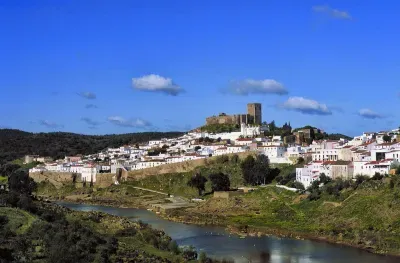
The fortified medieval village of Mértola sits on a remote rocky spur at the confluence of the rivers Guadiana and Oeiras in the southern Alentejo. Looking up from the river, Mértola appears as a set of sturdy stone walls containing a jumble of whitewashed, red-roofed houses all of which is crowned by the sturdy stone castle.
This is an ancient place with records dating back to the Phoenicians who established a port here. In Roman times the village was known as Myrtilis Iulia and both they and the Moors who followed built fortifications here, as did Dom Sancho II when he took the village in1238 during the Christian Reconquest of Portugal. It is this long history of successive occupations which define Mértola and make it such a fascinating place where successive civilisations have built upon each other.

The thick walls which surround the village seem to have not only protected it from the Moors and Castilians but from time itself. Mértola is regarded as a vila museu, a living museum which consists of a number of mini-museums dotted around the most historically important areas of the village. The Casa Romano is one such exhibition (or nucleo) with artifacts recovered from excavations of a Roman house found underneath the town hall. In a similar vein there is the Núcleo Visigótico which incorporates an early Christian basilica (Basílica Paleocristã). Located in the modern part of the village this excavated site contains the partially reconstructed columns and crypts of a 1,500 year old Christian temple with over thirty well preserved headstones.
Just inside the old walls, next to the Porta da Ribeira are the museums of religious art and Islamic art (Museu de Arte Sacra & Museu Arte Islamica). The latter is particularly interesting and reflects the profound Arabic influence on the village that can still be seen today. It contains some fine examples of Islamic art including ceramics, coins, jewellery and inscribed funerary stones.

The most obvious attraction in Mertola is the castle which provides great views of the village and countryside beyond. Dating back to the 13th century the central keep (torre de menagem) can be reached through the arched entrance. It now houses a small museum featuring an archaeological collection. The battlements of the tower are open to the public and afford the best views in town.
During the early Moorish settlement of Mertola the villages inhabitants lived within the walls of the castle itself. Over the years they spread out to occupy the area immediately around the castle, now known as the Moorish Quarter. This now forms what is known as the Alcáçova do Castelo, the excavated site of the Moorish village along with earlier Roman and Christian remains.

Just below the Moorish walls is the parish church, the Igreja Matriz (or Igreja de Nossa Senhora da Assunção) The church is on the site of a former mosque, which is not uncommon in itself, however, what is unusual is the degree to which it has retained its Arab features. Built in the 12th century the mosque was consecrated as a church around a hundred years later. Externally the church is somewhat unusual looking with its conical turrets and somewhat squat form. Inside there are a number of hints to its Islamic past such as the five-nave layout, horseshoe shaped arabesque archways and a mihrab - a small prayer niche behind the altar.
Mértola's rural surroundings are some of the most unspoilt in Portugal and form part of the 600 sq km (230 sq mile) Parque Natural de Vale Do Guadiana. This region is home to some interesting prehistoric sites as well as a rich variety of flora and fauna. Of particular interest is the birdlife which includes several endangered and rare species such as the black stork and Spanish imperial eagle.
Around 15 km north east of Mértola, close to the Spanish border are the abandoned pyrite and copper mines of São Domingos. The British-owned mine shut down in 1965 but left behind a scarred, but fascinating landscape. There are ruined mine workings everywhere along with flooded open cast pits. The imposing old mine headquarters have now been converted into a hotel, the Hotel São Domingos, while a museum has been created inside one of the old miners cottages. The casa do mineiro as it is known is a tiny windowless, single-room building which reflects how harsh life was for the miners here. Also of interest is the English cemetery which contains the graves of the mine managers and their families, many of whom were from Cornwall.